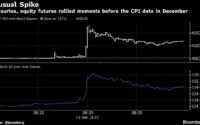Efforts to reduce risks within the nearly $24 trillion U.S. Treasury market, the world’s deepest and most liquid securities market, are ironically creating angst among market players.
The anxiety is centered on the concept of central clearing, a method used to reduce and manage risks in financial markets. In September, the Securities and Exchange Commission proposed rules that would mandate the central clearing of a large swath of Treasury transactions. Only a small percentage of such transactions have centrally cleared in recent years.
The biggest concern about central clearing is the cost of participating in it, according to a panel discussion at the 2022 U.S. Treasury Market Conference held at the New York Fed on Wednesday. Though panel participants generally agreed that the efforts would help to improve the Treasury market’s resiliency, they said that some players might not be able to absorb the additional costs and that it’s not clear how well the central-clearing system would work during periods of turmoil.
“The cost of transacting in the Treasury market is going to go up and, as dealers, we are concerned about that,” said Kavi Gupta, co-head of global rates trading and counterparty portfolio management for BofA Securities. Though larger players may adapt, smaller ones may not and the topic is “something our clients actively talk about.”
Concerns about liquidity in the Treasury market have been brewing for months, particularly as the Federal Reserve’s quantitative tightening process kicked into high gear. In October, BofA Securities warned that the “fragile” market was at risk of “large scale forced selling” or a surprise that might lead to a breakdown. And earlier this month, the Fed confirmed fears about low liquidity in what has historically been one of the financial system’s most stable corners.
Liquidity refers to the ease with which securities can be bought and sold, and a lack of it means that Treasurys can’t be transacted smoothly without significantly impacting the underlying prices on government debt. Exacerbating liquidity woes is the departure of big, regular buyers and the Fed’s aggressive rate hikes to combat inflation, which have generally encouraged investors to sell off bonds this year.
If the cost of transacting Treasurys becomes prohibitive for smaller dealers, then the question becomes “are you indirectly reducing liquidity” for the market, said panel participant Lynn Paschen, a senior portfolio manager at Schwab Asset Management. “That would be my main concern.” In addition, some funds are required to invest in Treasurys and additional costs may need to be passed on to shareholders, she said.
Gerald Pucci, Jr., managing director and global head of repo at BlackRock
BLK,
said he worries about rising costs for the firm’s pension- fund clients. “I would think any kind of central clearing, on the margin, is a positive,” but if undertaken too quickly “could be problematic.”
Most Treasury yields slipped on Wednesday, despite strong October retail-sales data. The 10-year rate
TMUBMUSD10Y,
fell below 3.7%, sending a popular bond-market gauge of impending recessions to the most negative level in more than 40 years.
Earlier on Wednesday, New York Fed President John Williams told conference participants that the Treasury market’s liquidity problems have the potential to interfere with the central bank’s ability to transmit monetary policy to the economy. Meanwhile, Nellie Liang, undersecretary for domestic finance at the Treasury Department, said that the UST market needs to be monitored for vulnerabilities, given the risks of a potential shock.


